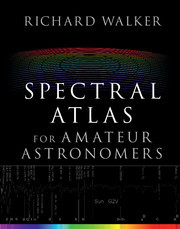Description
Spectral Atlas for Amateur Astronomers
A Guide to the Spectra of Astronomical Objects and Terrestrial Light Sources
Author: Walker Richard
A full colour reference featuring detailed commented spectral profiles of more than one hundred astronomical objects.
Language: English
Subject for Spectral Atlas for Amateur Astronomers:
Approximative price 94.04 €
In Print (Delivery period: 14 days).
Add to cart
Publication date: 07-2017
290 p. · 22.2x28.8 cm · Hardback
290 p. · 22.2x28.8 cm · Hardback
Description
/li>Contents
/li>Biography
/li>
Featuring detailed commented spectral profiles of more than one hundred astronomical objects, in colour, this spectral guide documents most of the important and spectroscopically observable objects accessible using typical amateur equipment. It allows you to read and interpret the recorded spectra of the main stellar classes, as well as most of the steps from protostars through to the final stages of stellar evolution as planetary nebulae, white dwarfs or the different types of supernovae. It also presents integrated spectra of stellar clusters, galaxies and quasars, and the reference spectra of some terrestrial light sources, for calibration purposes. Whether used as the principal reference for comparing with your recorded spectra or for inspiring independent observing projects, this atlas provides a breathtaking view into our Universe's past. The atlas is accompanied and supplemented by Spectroscopy for Amateur Astronomers, which explains in detail the methods for recording, processing, analysing and interpreting your spectra.
Preface; Acknowledgements; 1. Directory of plates; 2. Selection, processing and presentation of the spectra; 3. Terms, definitions and abbreviations; 4. Overview and characteristics of stellar spectral classes; 5. Spectral class O; 6. Spectral class B; 7. Spectral class A; 8. Spectral class F; 9. Spectral class G; 10. Spectral class K; 11. Spectral class M; 12. Spectral sequence on the AGB; 13. M(e) stars on the AGB; 14. Spectral class S on the AGB; 15. Carbon stars on the AGB; 16. Post AGB stars and white dwarf; 17. Wolf Rayet stars; 18. LBV stars; 19. Be stars; 20. Be shell stars; 21. PMS protostars; 22. Peculiar CP-stars; 23. Spectroscopic binaries; 24. Novae; 25. Supernovae; 26. Extragalactic objects; 27. Star clusters; 28. Emission nebulae; 29. Reflectance spectra of Solar System bodies; 30. Telluric molecular absorption; 31. The night sky spectrum; 32. The night sky spectrum; 33. Terrestrial and calibration light sources.
Richard Walker spent his career in civil engineering, planning large projects such as power plants, dams and tunnels. Now retired, in the last ten years he has focused increasingly on stellar astronomy and on the indispensable key to this topic - spectroscopy. He undertook a large observing project to record and document the spectra of the most important astronomical objects, and chose to share this gathered information for the benefit of other amateurs worldwide.
© 2024 LAVOISIER S.A.S.




